Menu
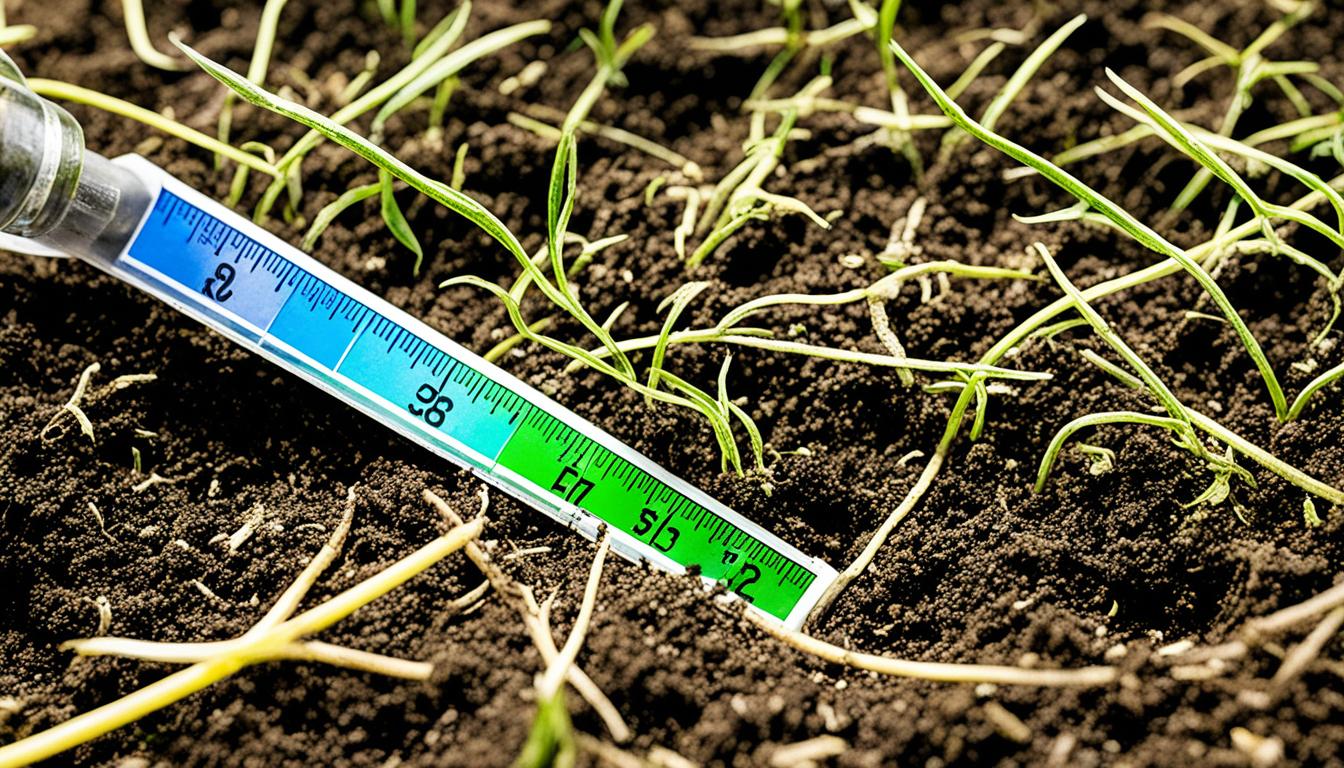
Did you know that every 1% point of organic matter in the top 6 inches of soil holds about 1,000 pounds of nitrogen? It also has 230 pounds of phosphorus and 165 pounds of sulfur per acre. These numbers show how much soil management can boost a garden’s productivity. Proper soil pH management is key to the success of homesteaders. It directly affects the health and growth of plants.
An ideal pH level for most plants falls between 6.0 and 7.0. This makes informed decisions about soil amending crucial. It results in better yields and healthier gardens. Keeping the soil’s pH level right is vital for a sustainable and productive garden or farm.
Soil pH management is key to better soil health. It’s crucial for getting the most out of gardening by influencing how plants use nutrients. Most plants grow best when the soil is slightly acidic to neutral, between pH 6.0 and 7.0. You might need to adjust this depending on your soil type.
Soil pH shows how acidic or alkaline the soil is on a scale of 0 to 14, with 7 being neutral. Below 7 is acidic, above is alkaline. The soil’s acidity affects how easily plants can get nutrients and how well microbes work, impacting plant health.
The right soil pH is essential for plants to use nutrients well. Very acidic soil can cause nutrient loss. Aim for a pH around 6.5. This supports good nutrient availability and the growth of helpful bacteria and earthworms in the soil.
Knowing the pH scale helps us manage soil pH:
Plants usually do well in soil with a pH of 6.2 to 6.8. You might need to adjust based on what you’re growing and your soil’s natural pH. For instance, lime raises pH and can counteract acidity. Dolomitic lime is best for adding magnesium to the soil.
Each soil type affects pH differently and needs specific care:
Testing your soil every few years helps keep it healthy. These tests guide you on what changes to make. For example, you might need sulfur for acid-loving plants. This focused care leads to better growth and productivity in gardens.
Determining soil pH is key for gardeners to achieve good plant health and yield. There are several methods like test strips, chemical test kits, and digital pH meters. Each has its own benefits and things to consider.
Test strips and kits are liked for their simple use and low cost. You add a soil sample to a solution, check the colour against a pH chart. This gives a fast idea of the pH, but may not always be super accurate.
Digital pH meters give more exact results. In a recent study, they gave readings very close to those of many labs. You just stick the probe into the soil for an instant reading. Don’t forget, you need to keep the meter calibrated for the best results.
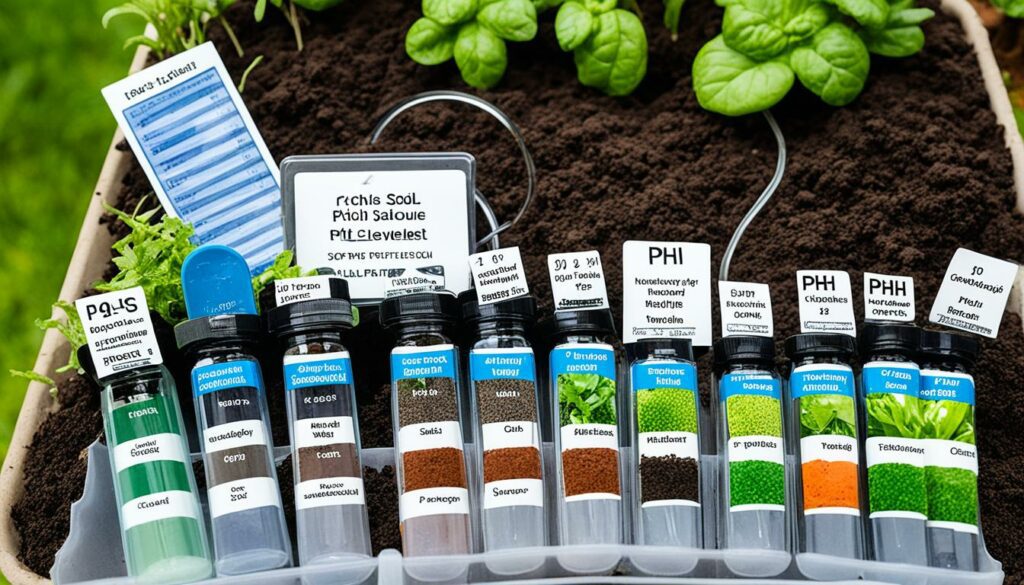
Getting soil samples ready properly is crucial for right pH answers. A good way is to mix soil with distilled water. This stops any pollution that might twist the results. The right preparation makes sure the tests show the real pH level of the soil.
Distilled water is a must in soil tests to get the pH right. Tap water has impurities that can mess up the test. For trustworthy results, especially with digital meters or kits, distilled water is needed. This step keeps pH tests accurate every time.
In conclusion, precise soil testing is vital for controlling the pH level. Choosing the best method, along with correct soil preparation and using distilled water, is crucial for dependable pH results. It helps make smart choices for your garden or farm.
Understanding pH results helps us know how to make soil right for plants. We look at the pH level, what nutrients are available, and what changes the soil needs. This knowledge guides our decisions.
Soil pH greatly impacts plant growth. Plants usually do best in soil with a pH of 6.0 to 7.5, where nutrients are easily absorbed. A pH lower than 7 is acidic, and higher is alkaline. We can improve soil by checking pH regularly and making necessary adjustments.
Knowing the pH helps flag nutrient problems. Plants need nutrients like phosphorus and potassium to be healthy. Lack of phosphorus can reduce roots and yield. A shortage of potassium affects nitrogen and water use. By acting on pH results, we can fix these issues with the right amendments.
We adjust soil pH by adding certain things. For acidic soil, we use lime to make it less acidic and help plants take in calcium and magnesium. To make soil more acidic, we add sulfur or organic matter. Understanding pH results tells us how much to add for the change we want.
To wrap it up, accurate soil testing and interpreting pH results are key to good soil for plants. This approach leads to well-optimised soil nutrients and the right pH levels. It’s the way to grow a lively and fruitful garden.
Getting the soil pH right is key for top plant growth. Learning how to adjust soil pH helps keep soil healthy. This includes tips and tricks I’m keen to share with you.
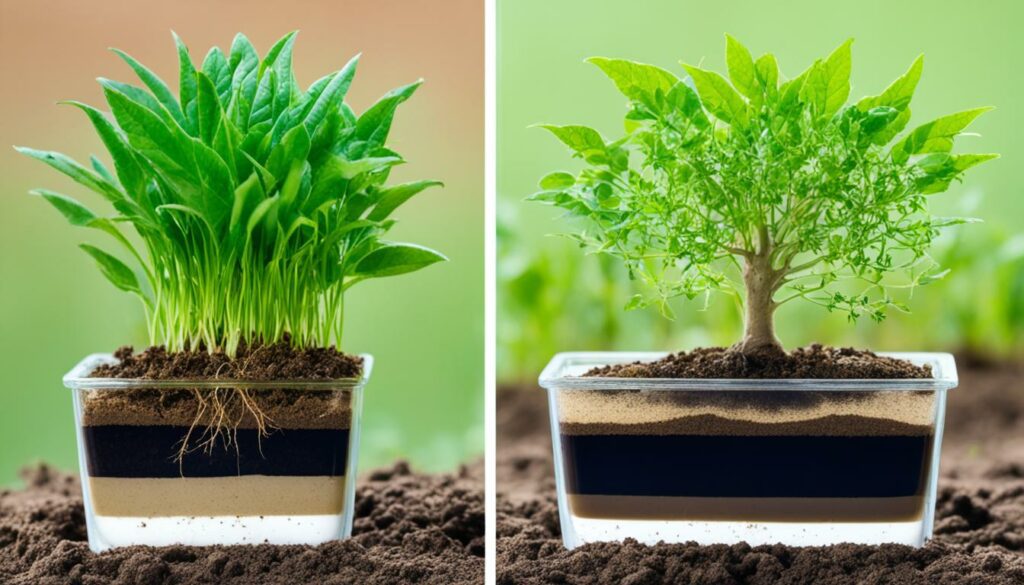
Lime is top for making soil less acidic. It’s mostly calcium carbonate. Soils in Iowa can be very different, from 4.5 to 8.2 pH. Using lime helps reach the right pH, especially for soils that are naturally acidic. Make sure to follow your soil’s lime needs closely for the best results.
For lowering soil pH, sulfur is the way to go. It works fast with options like aluminium sulfate. It can take from a few days to a few weeks to see changes. This is great for plants like blueberries that like more acidic soil.
Also, certain fertilisers can help keep the soil more acidic. Ammonium sulfate and urea are good for this, but beware of too much. Too much acidity can harm plants.
Compost, manure, and peat moss are perfect for pH and nutrients. Peat moss is great for lowering pH because it’s naturally acidic. These organic choices make changes slowly but are safe for the environment. Use them correctly to slowly adjust pH.
Regular soil tests are a smart move. They help you keep pH levels right, and your plants healthy. Good pH management means better gardening results.
Good soil pH management is key to a productive garden and healthy soil. It’s important to check pH levels often and know how the environment affects them. This helps keep nutrients and good microbes active.
Check out these facts about soil pH and how they impact crops:
| Crop | Yield (%) at pH 4.7 | Yield (%) at Optimal pH |
|---|---|---|
| Corn | 34% | 100% (pH 6.8) |
| Wheat | 68% | 100% (pH 6.8) |
| Soybeans | 65% | 100% (pH 6.8) |
| Oats | 77% | 100% (pH 7.5) |
| Barley | 0% | 100% (pH 7.5) |
| Alfalfa | 2% | 100% (pH 7.5) |
| Timothy (grass) | 31% | 100% (pH 7.5) |
Keeping soil pH between 6.5 and 7.0 not only helps with nutrients but also makes herbicides and insecticides work better. Doing this well can boost your garden yield. For example, by adding lime, plants can soak up more nutrients, leading to better growth and bigger harvests.
Soil pH and nutrients go hand in hand. It’s key to know how they mix for healthy plants. The soil’s pH affects if nutrients dissolve or not. It’s also critical for the work of tiny soil life in helping plants grow well.
The pH of soil really matters for nutrients to mix well with water. This affects how plants can use them. The best pH, between 6.0 and 7.0, lets plants easily get vital nutrients like nitrogen, phosphorus, and potassium.
But in places like Kansas and Oklahoma, too much nitrogen from fertilisers can drop the pH under 5.0. This hurts the plants because they can’t use certain nutrients. So, the pH needs constant checking and adjusting there.
In the southeastern US, where it rains a lot, soils often become too acidic. This is because too much rain washes away the alkaline substances. It makes keeping the right pH even more important. Regular soil tests and adding lime can keep the pH balanced. This helps plants take in nutrients well.
The level of pH also changes how well soil microbes work. These tiny organisms are key for getting nutrients ready for plants. They do best in slightly acidic to neutral pH. This supports the movement of nutrients and helps plants stay healthy.
If the pH is different deeper in the soil from the top, it can impact where roots grow. It also affects how well crops do. Adding compost, which works best at a neutral pH, helps create a good home for these microbes. This makes the soil better and nutrients more available for plants.
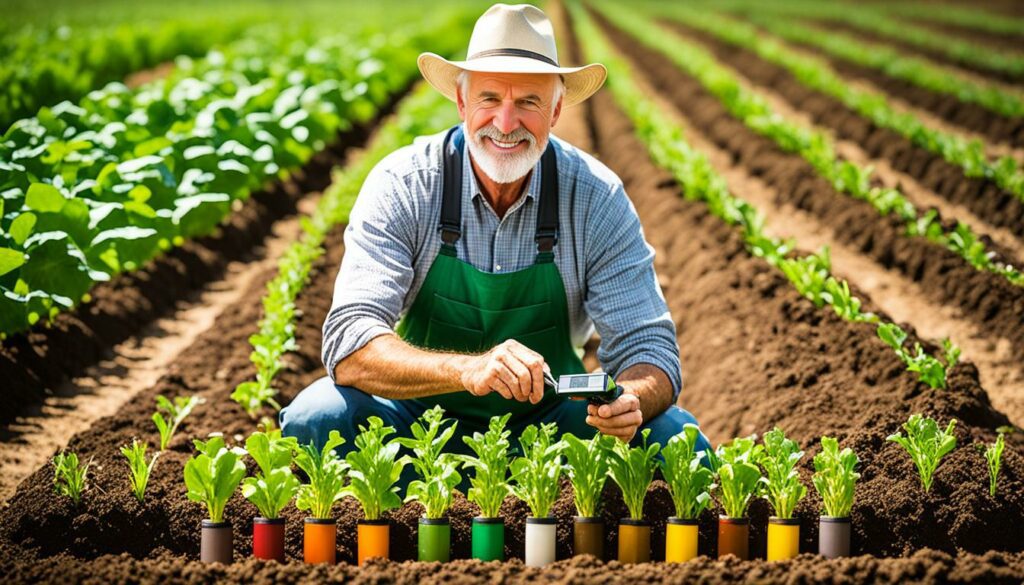
Managing soil pH right is crucial for making sure plants get the food they need. It keeps the microorganisms working hard too. All in all, it’s vital for a garden to be healthy and keep going strong.
It’s key to know how to change soil pH for a healthy garden. Being able to lower or raise the soil’s acidity can really help your plants grow better. This guide will show you how to get the perfect pH for your garden.
Some plants, like blueberries and azaleas, need acidic soil to thrive. You can use elemental sulfur to lower the pH. Apply 1 1/3 to 2 lb. per plant. Aluminium sulphate is another choice. It can lower the pH by about one unit with 4 to 6 lb. per plant. It’s best to do this before you plant sensitive flowers. It takes time and multiple applications to see big changes. So, be patient and keep checking the pH.
For crops that like more alkaline soil, use lime. There are different types, but they all help raise the soil’s pH. The goal is to get the pH between 6 and 7.5. If your soil is naturally very high in pH, over 7.5, you might need special care. Adding lime to your soil needs to be done evenly. This makes sure the pH rises everywhere.
It’s important to pick the right stuff for your soil. If you need to lower the pH, organic things like peat moss can help. But, they are slow and might need extra help like aluminium sulfate. Ammonium fertilisers can keep the soil acidic. But, they don’t lower the pH much. For raising the pH, go for things like hydrated lime. They work faster but be careful. Because they’re strong.
| Amendment | Purpose | Application Rate | Effectiveness |
|---|---|---|---|
| Elemental Sulfur | Lowering pH | 1 1/3 to 2 lb. per plant | Slow-acting |
| Aluminum Sulfate | Lowering pH | 4 to 6 lb. per plant | Moderate |
| Calcitic Limestone | Raising pH | Variable | Efficient |
| Hydrated Lime | Raising pH | Use cautiously | High potency |
| Peat Moss | Lowering pH | Supplementary | Slow-acting |
| Ammonium Fertilisers | Maintaining acid conditions | Regular use | Moderate |
In summary, knowing how to adjust soil pH is crucial for a thriving garden. Whether you’re making the soil more acidic or alkaline, the right choices are important. This ensures your plants have the best conditions to grow in.
Testing soil pH regularly is key to keeping your plants strong. It helps spot any problems early. This way, you can fix them before they harm your garden.
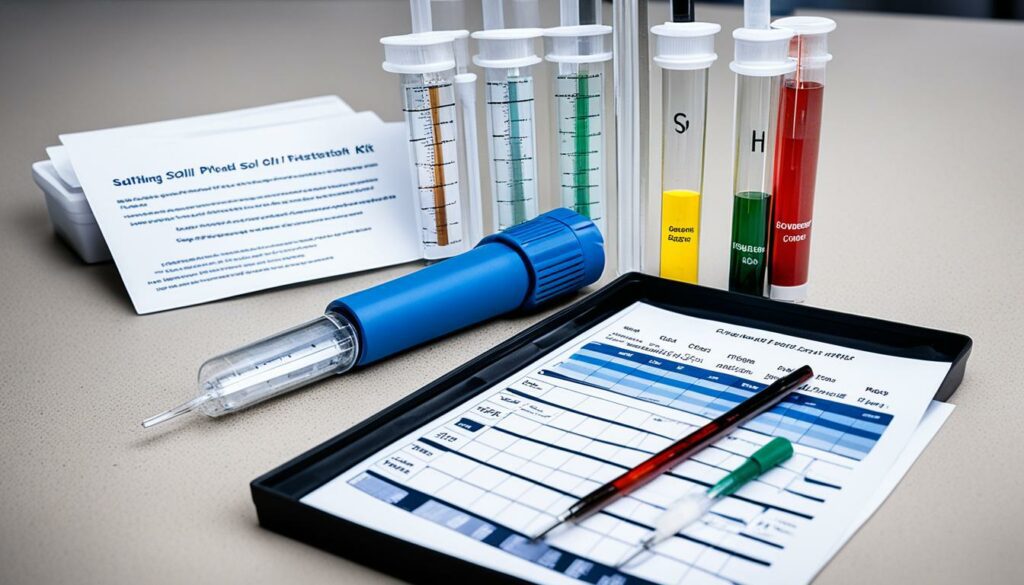
Testing your soil’s health should be done yearly. But your garden’s needs might call for more tests. Here’s a general idea:
You can easily get soil test kits from the Penn State University lab. They’re quick and affordable, giving results in about ten days.
Looking after your testing gear is crucial for accurate results. Here are some tips for keeping your equipment in top shape:
By keeping up with these steps, your testing tools will last longer. This means better soil checks and timely fixes for your garden.
| Soil Type | Testing Frequency | Special Considerations |
|---|---|---|
| Loam | Every 3-5 years | Balance of sand, silt, and clay |
| Sandy Soil | Every 2-3 years | More prone to pH changes |
| Clay Soil | Every 3-4 years | Holds pH steadier |
Test often and look after your tools for a healthy garden. This approach spots issues early and keeps your garden growing strong.
Soil pH is crucial for a successful garden. Studies show how pH affects plant health and growth. Gardeners can boost their plants by adjusting soil pH to suit them. This means looking into real stories and research for the best way to keep the soil just right.
In Kansas and Oklahoma, wheat suffered from too-low pH levels, causing toxic reactions. This shows why managing soil pH is so important. In the southeast, high rainfall makes the soil more acidic than in dry areas.
This acidity means constant monitoring and pH adjustments to keep crops healthy.
Legumes like soybeans affect soil pH a lot by reducing it over time. High acidity releases harmful metals that can hurt other plants. To combat this, using materials like limestone for pH control is key.
Knowing the best pH for each plant is vital. Tomatoes, for instance, prefer slightly acidic soil. Chelated fertilisers work best at higher pH levels.
| Crop | Optimal pH Range |
|---|---|
| Alfalfa | 6.6 – 7.0 |
| Corn | 5.8 – 6.2 |
| Soybean | 6.3 – 6.5 |
| Timothy | 6.0 – 7.0 |
Getting soil pH right is key to a good garden. By learning from studies and examples, gardeners can improve their soil management. This leads to better crops and a happier garden.
Getting soil pH right is key for healthy plants and good yield. But many people make the same mistakes. It’s important to know these to avoid them and get the most from your soil.
One big mistake is not checking the soil type before adjusting pH. Sandy, clay, and loamy soils all react differently when you add stuff. For example, sandy earth needs more adjustments because water washes away changes quickly. Clay, on the other hand, keeps those changes but it’s hard to make changes stick. Knowing this helps manage pH better.
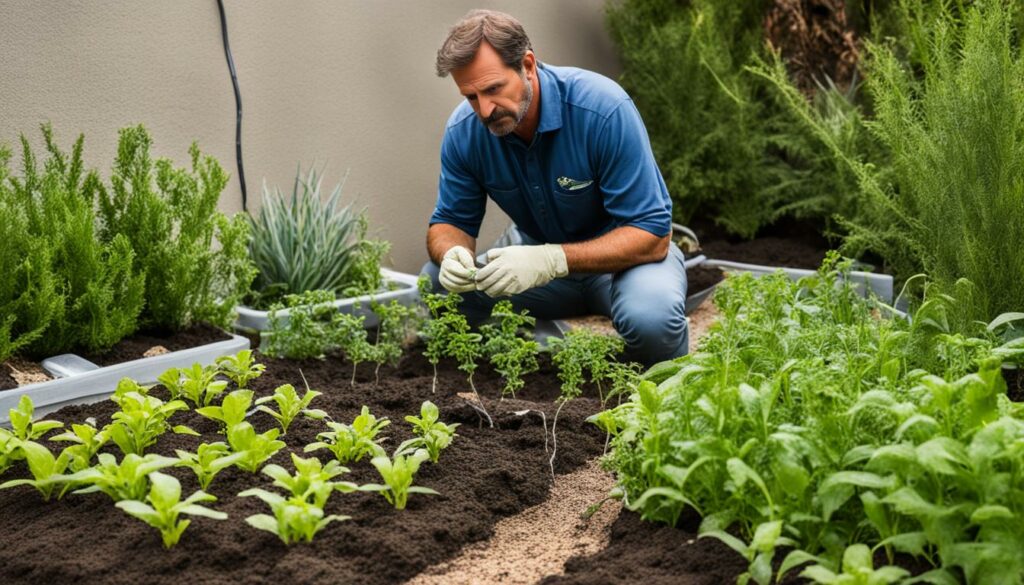
Applying amendments wrongly is a top mistake. Let’s look into some of the common issues and what they can cause:
The choice of calcium source is crucial too. Pick between Agricultural Lime, Dolomitic Lime, and Gypsum depending on your soil. Putting too much of something, like lime, can lock away needed nutrients, making them useless to plants.
| Problem | Cause | Impact |
|---|---|---|
| Over-application of Fertilisers | Too much toxic fertilisers | Soil dispersion, nutrient imbalance |
| Excessive Liming | Too much lime | Trace element deficiencies |
| High Compost Usage | Large compost applications | Oversupply of potassium, sodium, phosphorus |
| Fall Nitrogen Applications | Applying nitrogen in autumn | Soil carbon degradation |
| Improper Water Alkalinity | High alkalinity in water | Reduced nutrient solubility |
Know the soil pH management errors and how to apply amendments right. This knowledge is key to better plant health and bigger harvests.
Getting the right soil pH helps plants get needed nutrients and keeps the soil healthy. It’s key to grow more food. By setting the soil pH between 6.0 and 7.5, plants can take in the important nutrients they need.
Getting soil pH right means I grow more crops. In some areas, if the soil is too acidic, plants can’t get the nutrients they need. Changing the soil pH can make a big difference. Adding things like lime helps too.
Lime can make the soil less acidic. This helps more crops grow. It also makes plants like tomatoes, that need the right soil pH, healthier.
Good soil pH is vital for plants’ well-being. Too much acid makes harmful minerals like aluminium more likely to hurt plants. This can make plants get sick or not grow well. By fixing the soil pH, we help plants stay healthy and grow strong.
It stops disease and makes sure plants aren’t missing any nutrients. Plus, using lime adds important minerals like calcium and magnesium. These minerals help plants grow and make better fruits.
Right soil pH also helps good bacteria and nutrients in the soil work better. This keeps plants healthy. Keeping the soil’s pH in check means better gardens. It shows how important managing soil pH is for anyone who loves gardening.
Keeping soil pH steady is crucial for good crop yields and soil health. It involves managing the soil’s natural changes as the seasons pass. This process also deals with the impact of growing different crops in the same area over time.
Soil pH changes with the seasons. Rainfall, temperature, and decay of organic matter all play a part. To adjust pH with the seasons:
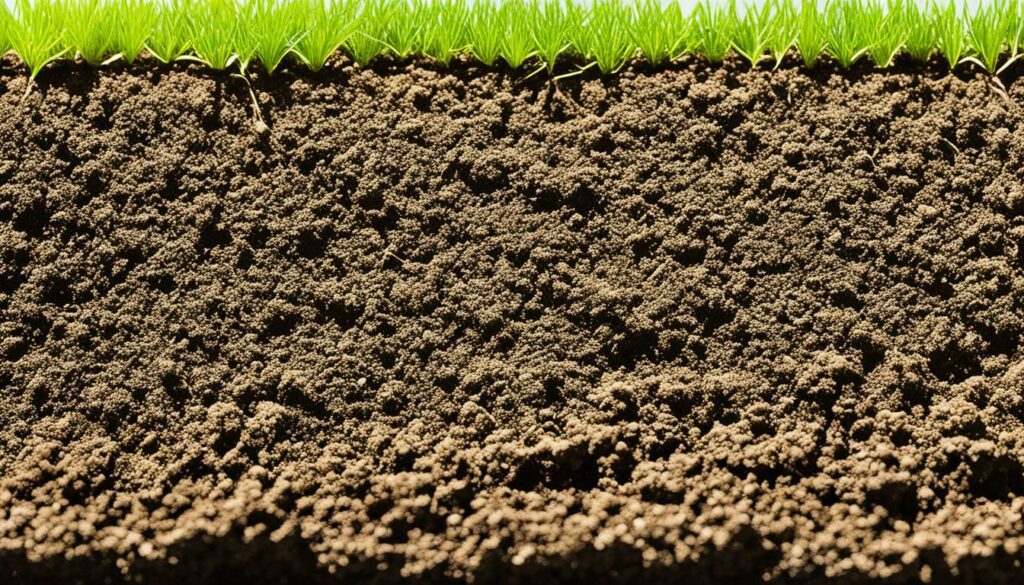
Crop rotation is key to keeping soil pH steady over time. Different plants need different nutrients and prefer different pH levels. For instance, after growing corn, it’s wise to add lime before planting wheat, which likes neutral soils.
Below is a table showing how crop yields change with soil pH:
| Crop | Yield at pH 4.7 | Yield at pH 7.5 |
|---|---|---|
| Wheat | 68 | 99 |
| Soybean | 65 | 93 |
| Barley | 0 | 100 |
| Alfalfa | 2 | 100 |
| Timothy Grass | 31 | 95 |
Barley, for example, needs careful pH control to achieve high yields. Varying the crops you grow can help keep soil pH steady, which boosts soil health.
Also, using the right amounts of nitrogen and sulfur, along with water rich in calcium or magnesium, helps. Adding organic matter does, too. These steps all contribute to maintaining soil pH in the long run.
In the end, keeping soil pH stable and adjusting it by season is key for sustainable farming. It helps plants thrive in changing conditions.
Knowing what plants like in terms of pH is key to a healthy garden. It helps you pick plants that will grow strong in your soil. We’ll look at plants for both acidic and alkaline soil.
Some garden favourites like it when the soil is a bit sour. They do best in an acid soil, around 4.5 to 6.0 pH.
For these plants, keeping the soil slightly acidic is a must. You can use sulfur to adjust pH, but follow instructions to avoid overdoing it.
Others do great in an alkaline setup. These plants prefer a higher pH, even above 7.0.
Alkaline soil can starve plants of iron, manganese, and zinc. To help, adding compost or manure can balance the pH and provide nutrients.
So, it’s vital to choose plants that match your soil’s pH for a good garden. Knowing about acidic soil plants and those that prefer alkaline types helps ensure your garden flourishes. Testing your soil often is a smart move. It helps you select the best plants, making your garden the best it can be.
It’s key to know about soil pH environmental factors for a healthy garden. Rainfall really changes the acidity of soil. High rainfall makes soil more acidic by washing out minerals. In contrast, low rainfall leads to more alkaline soil.

Fertiliser use is crucial too. Nitrogen fertilisers, especially those with ammonium, make soil more acidic. With each pound of nitrogen, you need 1.8 pounds of calcium carbonate to balance the acid. The kind of fertiliser you use also affects soil pH, so keep an eye on it. The goal is to keep pH between 6.0 and 7.5.
The soil’s natural mix affects its pH too. Soils full of organic matter can buffer pH changes well. They are stable. But sandy soils with less organic matter can see their pH swing a lot. This shift can hurt the plants by changing nutrient availability.
Soil type matters a lot for getting nutrients to plants. A low soil pH can slow down nitrogen use and phosphorus availability. It can also hurt the breakdown of harmful chemicals. Metals in the soil might become more or less harmful to plants too.
To battle against pH changes, testing the soil often is a must. Using fertilisers right and adding lime can fix soil acidity. In some states like Kansas and Oklahoma, liming helps avoid aluminium toxicity in soil.
I suggest mixing organic and inorganic stuff to keep the soil healthy. Using stuff like ground limestone and fluid lime can keep soil pH steady. This makes for a better garden.
| Crop | Optimal pH |
|---|---|
| Barley | 6.0 – 7.5 |
| Corn | 6.0 – 7.5 |
| Wheat | 5.0 – 7.5 |
| Cotton | 5.5 – 7.5 |
| Soybeans | 5.5 – 7.5 |
It’s vital to master soil pH to make our gardens healthy and productive. We need to balance hydrogen ions with ions like calcium to control soil acidity. Regular monitoring becomes crucial as rain can make the soil more acidic over time, due to the acid in rainwater.
Farming, especially intensive practices, can make the soil more acidic. This happens when we use nitrogen fertilisers. Knowing the preferred pH of different plants is key. For instance, blueberries like acidic soil, while citrus plants do better in slightly less acidic soil, about 6.0 pH. It also underlines the importance of regular testing to know what our soil needs to support plant growth.
Using materials like calcitic limestone or dolomitic limestone helps counter soil acidity. This boosts plant growth and output. Treating soil with care, like doctors do with patients, ensures our gardening efforts pay off. With careful and regular pH level checks, our gardens will flourish. This work ensures every harvest season is rewarding and full of healthy produce.
Soil pH shows if the soil is acidic or not. It’s very important for plants. It’s rated from 0 to 14. A rating of 7 is neutral. Below 7 is acid, above 7 is alkaline.
The right soil pH helps plants use nutrients well. They do best in pH 6.0 to 7.0. Keeping an eye on and adjusting soil pH helps your garden stay healthy.
Sandy and clay soils affect pH differently. Sand can make soil more acidic, clay more alkaline. Knowing which soil type you have helps manage pH better.
You can use test strips, chemical kits, or digital meters. Each method needs soil-water mix and distilled water for accuracy. Testing soil pH often is key to keeping your garden healthy.
Understanding the pH scale is important for plant growth. Most plants like pH 6.0 to 7.5. Tests can show which nutrients your soil needs.
Use lime to raise pH or sulfur to lower it. Compost and manure also help keep pH in check. Matching the amendment to your soil’s needs is vital.
Test your soil pH yearly or after big changes. Often testing keeps your soil ready for plants to grow well.
Yes, the right pH level boosts how well your garden grows. Plants get more nutrients when the pH is correct. This makes them healthier and more productive.
Mistakes include forgetting that soil type affects pH change. Also, using the wrong amount or type of amendment is a common error. Knowing your soil helps avoid these mistakes and keeps plants healthy.
Soil pH impacts how well plants get their nutrients. A little bit of acidity is good for most plants. It helps nutrients move into the soil where plants can use them.
Rain and fertilisers can change the pH over time. Paying attention and making small changes helps keep the pH at a level plants like.
Different plants like different pH levels. Knowing these preferences helps you choose the right plants. You can also change the soil pH to fit the plants you want to grow.